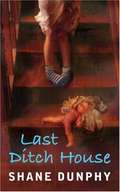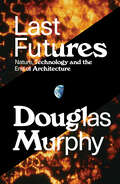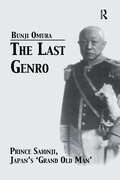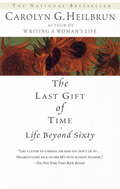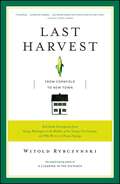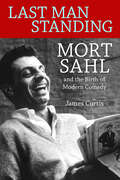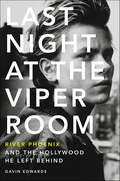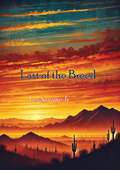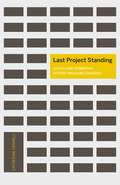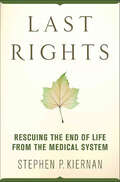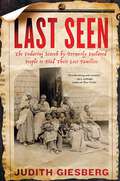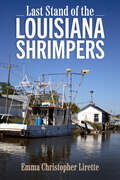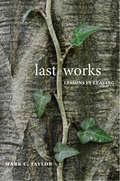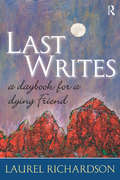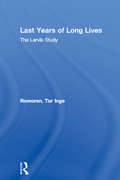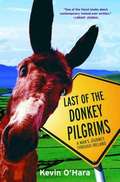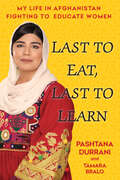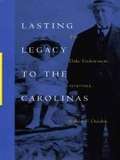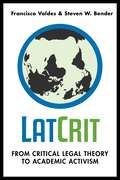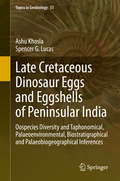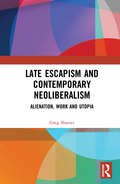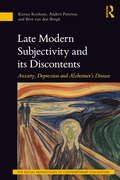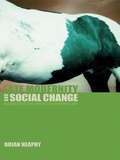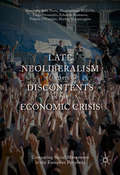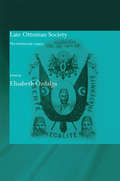- Table View
- List View
Last Ditch House
by Shane DunphyThe cases recounted here by the author-- a child protection worker, are those of four children from very different aspects of Irish society, each with a unique story to tell.
Last Futures: Nature, Technology and the End of Architecture
by Douglas MurphyWhatever happened to the last utopian dreams of the city?In the late 1960s the world was faced with impending disaster: the height of the Cold War, the end of oil and the decline of great cities throughout the world. Out of this crisis came a new generation that hoped to build a better future, influenced by visions of geodesic domes, walking cities and a meaningful connection with nature. In this brilliant work of cultural history, architect Douglas Murphy traces the lost archeology of the present day through the works of thinkers and designers such as Buckminster Fuller, the ecological pioneer Stewart Brand, the Archigram architects who envisioned the Plug-In City in the '60s, as well as co-operatives in Vienna, communes in the Californian desert and protesters on the streets of Paris. In this mind-bending account of the last avant-garde, we see not just the source of our current problems but also some powerful alternative futures.From the Hardcover edition.
Last Genro
by OmuraFirst Published in 2005. Routledge is an imprint of Taylor & Francis, an informa company.
Last Gift of Time
by Carolyn G. HeilbrunWhen she was young, distinguished author and critic Carolyn Heilbrun solemnly vowed to end her life when she turned seventy. But on the advent of that fateful birthday, she realized that her golden years had been full of unforeseen pleasures. Now, the astute and ever-insightful Heilbrun muses on the emotional and intellectual insights that brought her "to choose each day for now, to live." There are reflections on her new house and her sturdy, comfortable marriage; sweet solitude and the pleasures of sex at an advanced age; the fascination with e-mail and the joy of discovering unexpected friends. Even the encroachments of loss, pain, and sadness that come with age cannot spoil Heilbrun's moveable feast. They are merely the price of bountiful living. (From the Trade Paperback edition.)
Last Harvest: From Cornfield to New Town
by Witold RybczynskiIn Last Harvest, the award-winning author of Home and A Clearing in the Distance tells the compelling story of New Daleville, a brand-new residential subdivision in rural Pennsylvania. When Witold Rybczynski first heard about New Daleville, it was only a developer's idea, attached to ninety acres of cornfield an hour and a half west of Philadelphia. Over the course of five years, Rybczynski met everyone involved in the transformation of this land -- from the developers, to the community leaders whose approvals they needed, to the home builders and sewage experts and, ultimately, the first families who moved in. Always eloquent and illuminating, Rybczynski looks at this "neotraditional" project, with its houses built close together to encourage a sense of intimacy and community, and explains the trends in American domestic architecture -- from where we place our kitchens and fences to why our bathrooms get larger every year. As Publishers Weekly said, "Rybczynski provides historical and cultural perspective in a style reminiscent of Malcolm Gladwell, debunking the myth of urban sprawl and explaining American homeowners' preference for single-family dwellings. But Rybczynski also excels at 'the close-up,' John McPhee's method of reporting, where every interview reads like an intimate conversation, and a simple walk down neighborhood sidewalks can reveal a wealth of history." Last Harvest is a charming must-read for anyone interested in where we live today -- and why -- by one of our most acclaimed and original cultural writers.
Last Man Standing: Mort Sahl and the Birth of Modern Comedy
by James CurtisA Times Literary Supplement 2017 Book of the YearOn December 22, 1953, Mort Sahl (1927–2021) took the stage at San Francisco's hungry i and changed comedy forever. Before him, standup was about everything but hard news and politics. In his wake, a new generation of smart comics emerged—Shelley Berman, Mike Nichols and Elaine May, Lenny Bruce, Bob Newhart, Dick Gregory, Woody Allen, and the Smothers Brothers, among others. He opened up jazz-inflected satire to a loose network of clubs, cut the first modern comedy album, and appeared on the cover of Time surrounded by caricatures of some of his frequent targets such as Dwight Eisenhower, Richard Nixon, Adlai Stevenson, and John F. Kennedy. Through the extraordinary details of Sahl's life, author James Curtis deftly illustrates why Sahl was dubbed by Steve Allen as “the only real political philosopher we have in modern comedy.”Sahl came on the scene the same year Eisenhower and Nixon entered the White House, the year Playboy first hit the nation's newsstands. Clad in an open collar and pullover sweater, he adopted the persona of a graduate student ruminating on current events. “It was like nothing I'd ever seen,” said Woody Allen, “and I've never seen anything like it after.” Sahl was billed, variously, as the Nation's Conscience, America's Only Working Philosopher, and, most tellingly, the Next President of the United States. Yet he was also a satirist so savage the editors of Time once dubbed him “Will Rogers with fangs.”Here, for the first time, is the whole story of Mort Sahl, America's iconoclastic father of modern standup comedy. Written with Sahl's full cooperation and the participation of many of his friends and contemporaries, it delves deeply into the influences that shaped him, the heady times in which he soared, and the depths to which he fell during the turbulent sixties when he took on the Warren Commission and nearly paid for it with his career.
Last Night at the Viper Room: River Phoenix and the Hollywood He Left Behind
by Gavin EdwardsA biography elucidating the Academy Award–nominee’s meteoric rise, his tragic end, and his legacy.At the dawn of the 1990s, a new crew of leading men—Johnny Depp, Nicolas Cage, Keanu Reeves, and Brad Pitt—was rocketing toward stardom. River Phoenix, however, stood in front of the pack. But behind Phoenix’s talent and beautiful public face was a young man who had been raised in a cult by nonconformist parents, who was burdened with supporting his family from a young age, and who eventually succumbed to addiction, dying of an overdose in front of the Viper Room, West Hollywood’s storied club, at twenty-three.Last Night at the Viper Room is part biography, part cultural history of the 1990s, and part celebration of a Hollywood icon gone too soon. Full of interviews from his fellow actors, directors, friends, and family, this book shows the role River Phoenix played in creating the place of the actor in our modern culture and the impact his work still makes today.
Last Of The Breed
by Les Savage Jr.Last of the Breed by Les Savage Jr. is a gripping and emotionally charged Western novel that explores the struggle for survival, identity, and justice in the rugged frontier of the American West. With vivid storytelling and richly drawn characters, Savage delivers a tale that is as much about the untamed wilderness as it is about the complexities of human nature.The story follows a Native American protagonist, a proud and resourceful warrior, who finds himself at the center of a fierce conflict between his people’s traditions and the relentless encroachment of settlers and soldiers. As one of the last of his kind, he must navigate a world that is rapidly changing, fighting to preserve his heritage while confronting the harsh realities of survival in a hostile land.As alliances shift and tensions rise, the protagonist becomes a symbol of resilience and defiance, embodying the spirit of those who refuse to be erased by history. Alongside moments of action and adventure, Savage infuses the narrative with themes of loyalty, honor, and the enduring bond between people and the land they call home.With its fast-paced plot, compelling characters, and evocative depiction of the Western frontier, Last of the Breed is a classic tale of courage and perseverance. Savage captures the clash of cultures and the profound sense of loss experienced by those who fought to protect their way of life against overwhelming odds.Perfect for fans of Western fiction and historical dramas, Last of the Breed is a powerful and unforgettable story that reflects on the enduring legacy of the American West and the people who shaped its history.
Last Project Standing: Civics and Sympathy in Post-Welfare Chicago (A Quadrant Book)
by Catherine FennellIn 1995 a half-vacant public housing project on Chicago&’s Near West Side fell to the wrecking ball. The demolition and reconstruction of the Henry Horner housing complex ushered in the most ambitious urban housing experiment of its kind: smaller, mixed-income, and partially privatized developments that, the thinking went, would mitigate the insecurity, isolation, and underemployment that plagued Chicago's infamously troubled public housing projects. Focusing on Horner&’s redevelopment, Catherine Fennell asks how Chicago&’s endeavor transformed everyday built environments into laboratories for teaching urbanites about the rights and obligations of belonging to a city and a nation that seemed incapable of taking care of its most destitute citizens. Drawing on more than three years of ethnographic and archival research, she shows how collisions with everything from haywire heating systems and decaying buildings to silent neighbors became an education in the possibilities, but also the limits, of collective care, concern, and protection in the aftermath of welfare failure. As she documents how the materiality of both the unsuccessful older projects and the recently emerging housing fosters feelings of belonging and loss, her work engages larger debates in critical anthropology and poverty studies—and opens a vital new perspective on the politics of space, race, and development in urban America
Last Rights: Rescuing the End of Life from the Medical System
by Stephen P. KiernanIn Last Rights, award-winning journalist Stephen P. Kiernan shows how patients and families can regain control of the dying process, creating familial intimacy like never before. "Gripping…A superb resource for boomers dealing with their parents' final days…as well as for health-care professionals who need to hear this story from the other side."-Kirkus ReviewsWith advances in medicine, technology, and daily diet and exercise practices, Americans are living longer than ever before. We have an unprecedented opportunity for meaningful closure – free of pain, among loved ones, with our affairs in order and spiritual calm attained. Instead, most of us discover that our doctor has minimal training in providing end-of-life care, and will seek to extend life no matter how painful, expensive and futile that effort might be.Bolstered by both scientific research and intimate portraits of people from all walks of life, Last Rights offers a hopeful, profound vision for patients, doctors, and families: a way to honor people during their greatest vulnerability, a chance for families to reconnect, an opportunity for the medical system to treat patients with ultimate respect, a time to give comfort and compassion to those we most love.
Last Seen: The Enduring Search by Formerly Enslaved People to Find Their Lost Families
by Judith GiesbergDrawing from an archive of nearly five thousand letters and advertisements, the riveting, dramatic story of formerly enslaved people who spent years searching for family members stolen away during slavery.Of all the many horrors of slavery, the cruelest was the separation of families in slave auctions. Spouses and siblings were sold away from one other. Young children were separated from their mothers. Fathers were sent down river and never saw their families again. As soon as slavery ended in 1865, family members began to search for one another, in some cases persisting until as late as the 1920s. They took out &“information wanted&” advertisements in newspapers and sent letters to the editor. Pastors in churches across the country read these advertisements from the pulpit, expanding the search to those who had never learned to read or who did not have access to newspapers. These documents demonstrate that even as most white Americans—and even some younger Black Americans, too—wanted to put slavery in the past, many former slaves, members of the &“Freedom Generation,&” continued for years, and even decades, to search for one another. These letters and advertisements are testaments to formerly enslaved people&’s enduring love for the families they lost in slavery, yet they spent many years buried in the storage of local historical societies or on microfilm reels that time forgot. Judith Giesberg draws on the archive that she founded—containing almost five thousand letters and advertisements placed by members of the Freedom Generation—to compile these stories in a narrative form for the first time. Her in-depth research turned up additional information about the writers, their families, and their enslavers. With this critical context, she recounts the moving stories of the people who placed the advertisements, the loved ones they tried to find, and the outcome of their quests to reunite. This story underscores the cruelest horror of slavery—the forced breakup of families—and the resilience and determination of the formerly enslaved. Thoughtful, heart-wrenching, and illuminating, Last Seen finally gives this lesser-known aspect of slavery the attention it deserves.
Last Stand of the Louisiana Shrimpers
by Emma Christopher LiretteIn recent years, shrimpers on the Louisiana coast have faced a historically dire shrimp season, with the price of shrimp barely high enough to justify trawling. Yet, many of them wouldn’t consider leaving shrimping behind, despite having transferrable skills that could land them jobs in the oil and gas industry. Since 2001, shrimpers have faced increasing challenges to their trade: an influx of shrimp from southeast Asia, several traumatic hurricane seasons, and the largest oil spill at sea in American history. In Last Stand of the Louisiana Shrimpers, author Emma Christopher Lirette traces how Louisiana Gulf Coast shrimpers negotiate land and blood, sea and freedom, and economic security and networks of control. This book explores what ties shrimpers to their boats and nets. Despite feeling trapped by finances and circumstances, they have created a world in which they have agency. Lirette provides a richly textured view of the shrimpers of Terrebonne Parish, Louisiana, calling upon ethnographic fieldwork, archival research, interdisciplinary scholarship, and critical theory. With evocative, lyrical prose, she argues that in persisting to trawl in places that increasingly restrict their way of life, shrimpers build fragile, quietly defiant worlds, adapting to a constantly changing environment. In these flickering worlds, shrimpers reimagine what it means to work and what it means to make a living.
Last Works: Lessons in Leaving
by Mark C. TaylorA powerful consideration of the lessons imparted in the final works of essential writers and philosophers For many today, retirement and the leisure said to accompany it have become vestiges of a slower, long-lost time. In a world where the sense of identity is tied to work and careers, to stop working often is to become nobody. In this deeply perceptive and personal exploration of last works, Mark C. Taylor poignantly explores the final reflections of writers and thinkers from Kierkegaard to David Foster Wallace. How did they either face or avoid ending and leaving? What do their lessons in ending teach us about living in the time that remains for us? Some leavings brought relief, even joy, while others brought pain and suffering. Whether the cause was infirmity, impending death, or simply exhaustion and ennui, the ways these influential voices fell silent offer poignant examples of people withdrawing from the world’s stage. Throughout this learned and moving book, Taylor probes how the art of living involves learning to leave gracefully.
Last Writes: A Daybook for a Dying Friend (Writing Lives: Ethnographic and Autoethnographic Narratives)
by Laurel RichardsonBetty Frankel Kirschner succumbed to emphysema one day in June. She had been a long-term professor at Kent State University, founding member of the feminist caucus in sociology, a political activist, a chain smoker. Close friend Laurel Richardson, a key figure in literary turn in ethnographic writing, kept a daybook, relating their conversations and interactions over Betty’s last few months. Rich in memory, emotion, dreams, and life-and-death decisions, the daybook chronicles the ups and down of a terminally ill woman and the impact that illness has on friends, colleagues, and family alike. Richardson also grapples with the ethics of writing deeply personal narratives. Part memoir, part sociological analysis, part eulogy to a departed friend, Richardson opens a poignant window into living an academic life, and ending it.
Last Years of Long Lives: The Larvik Study
by Tor Inge RomorenThe Last Years of Long Lives is a unique account of that period of old age which precedes death. Based on 400 complete individual histories and covering a twenty-year period, it looks at the experiences of people over eighty years old in three important areas: disability, family life and health care. Using the life-course approach to research, it reveals rich data about the contributions of formal and informal care and how life expectancy and experiences of disability interact with experiences of care.The reader is invited to conceptualise these phenomena as processes in continuous time - processes that are sometimes long and complex, sometimes short and simple - and learns about the four types of disability career before death. At the same time, the author presents a three-stage model of informal care and examines the main patterns of formal service use.The Last Years of Long Lives presents a new way of looking at old age for students, researchers, practitioners and policy makers and gives a comprehensive picture of what has been called 'the fourth age'.
Last of the Donkey Pilgrims: A Man's Journey Through Ireland
by Kevin O'HaraKevin O'Hara's journey of self-discovery begins as a mad lark: who in their right mind would try to circle the entire coastline of Ireland on foot and with a donkey and cart no less? But Kevin had promised his homesick Irish mother that he would explore the whole of the Old Country and bring back the sights and the stories to their home in Massachusetts. Determined to reach his grandmother's village by Christmas Eve, Kevin and his stubborn but endearing donkey, Missie, set off on 1800-mile trek along the entire jagged coast of a divided Ireland. Their rollicking adventure takes them over mountains and dales, through smoky cities and sleepy villages, and into the farmhouses and hearts of Ireland's greatest resource --its people. Along the way, Kevin would meet incredible characters, experience Ireland in all of its glory, and explore not only his Irish past, but find his future self.
Last to Eat, Last to Learn: My Life in Afghanistan Fighting to Educate Women
by Pashtana Durrani Tamara BraloA Ms. Magazine Pick for Most Anticipated Feminist Books of 2023&“Pashtana&’s story highlights the resourcefulness and bravery of young women in Afghanistan. I hope readers will be inspired by her mission to give every girl the education she deserves and the opportunity to pursue her dreams.&”—Malala Yousafzai In the spirit of I am Malala and Our House is On Fire by Greta Thunberg, this is the astonishing true story of the Malala Fund Education Champion Award-winner, founder of the NGO LEARN, and women&’s education activist whose advocacy for the disappearing girls of rural Afghanistan has led to her being ruthlessly targeted by the Taliban. Inspired by generations of her family&’s unwavering belief in the power of education, Pashtana Durrani recognized her calling early in life: to educate Afghanistan&’s girls and young women, raised in a society where learning is forbidden. In a country devastated by war and violence, where girls are often married off before reaching their teenage years and prohibited from leaving their homes, heeding that call seemed both impossible and dangerous. Pashtana was raised in an Afghan refugee camp in Pakistan where her father, a tribal leader, founded a community school for girls within their home. Fueled by his insistence that despite being a girl, she mattered and deserved an education, Pashtana was sixteen when, against impossible odds, she was granted a path out of the refugee camp: admittance to a preparatory program at Oxford. Unthinkably and to her parents&’ horror, she chose a different path. She chose Afghanistan. Pashtana founded the nonprofit LEARN and developed a program for getting educational materials directly into the hands of girls in remote areas of the country, training teachers in digital literacy. Her commitment to education has made her a target of the Taliban. Still, she continues to fight for women&’s education and autonomy in Afghanistan and beyond. Courageous and inspiring, Last to Eat, Last to Learn is the story of how just one person can transform a family, a tribe, a country. It reminds us of the emancipatory power of learning and the transformational potential that lies within each of us.
Lasting Legacy to the Carolinas: The Duke Endowment, 1924–1994
by Robert F. DurdenLike the majority of the founders of large philanthropic foundations in the United States, James B. Duke assumed that the Duke Endowment, which he established in 1924, would continue its charitable activity forever. Lasting Legacy to the Carolinas is an examination of the history of this foundation and the ways in which it has--and has not--followed Duke's original design.In this volume, Robert F. Durden explores how the propriety of linking together a tax-free foundation and an investor-owned, profit-seeking business like the Duke Power Company has significantly changed over the course of the century. Explaining the implications of the Tax Reform Act of 1969 for J. B. Duke's dream, Durden shows how the philanthropist's plan to have the Duke Endowment virtually own and ultimately control Duke Power (which, in turn, would supply most of the Endowment's income) dissolved after the death of daughter Doris Duke in 1993, when the trustees of the Endowment finally had the unanimous votes needed to sever that tie. Although the Endowment's philanthropic projects--higher education (including Duke University), hospitals and health care, orphan and child care in both North and South Carolina, and the rural Methodist church in North Carolina--continue to be served, this study explains the impact of a century of political and social change on one man's innovative charitable intentions. It is also a testimony to the many staff members and trustees who have invested their own time and creative energies into further benefiting these causes, despite decades of inevitable challenges to the Endowment.This third volume of Durden's trilogy relating to the Dukes of Durham will inform not only those interested in the continuing legacy of this remarkable family but also those involved with philanthropic boards, charitable endowments, medical care, child-care institutions, the rural church, and higher education.
LatCrit: From Critical Legal Theory to Academic Activism
by Steven W. Bender Francisco ValdesExamines LatCrit’s emergence as a scholarly and activist community within and beyond the US legal academyEmerging from the US legal academy in 1995, LatCrit theory is a genre of critical outsider jurisprudence—a vital hub of contemporary scholarship that includes Feminist Legal Theory and Critical Race Theory, among other critical schools of legal knowledge. Its basic goals have been: (1) to develop a critical, activist, and inter-disciplinary discourse on law and society affecting Latinas/os/x, and (2) to foster both the development of coalitional theory and practice as well as the accessibility of this knowledge to agents of social and legal transformative change.This slim volume tells the story of LatCrit’s growth and influence as a scholarly and activist community. Francisco Valdes and Steven W. Bender offer a living example of how critical outsider academics can organize long-term collective action, both in law and society, that will help those similarly inclined to better organize themselves. Part roadmap, part historical record, and part a path forward, LatCrit: From Critical Legal Theory to Academic Activismshows that with coalition, collaboration, and community, social transformation can take root.
Late Cretaceous Dinosaur Eggs and Eggshells of Peninsular India: Oospecies Diversity and Taphonomical, Palaeoenvironmental, Biostratigraphical and Palaeobiogeographical Inferences (Topics in Geobiology #51)
by Spencer G. Lucas Ashu KhoslaThis book documents analyses of the Late Cretaceous dinosaur nesting sites of the Lameta Formation at Jabalpur, Districts Dhar and Jhabua, Madhya Pradesh; Districts Kheda and Panchmahal (Gujarat); and the Pisdura, Dongargaon and Pavna sectors in the Chandrapur Districts of Maharashtra, which are exposed in India along an east-west and central axis. In this work, special emphasis has been given to the dinosaur nesting sites of the east-central Narbada River region, including its regional geology. The work was undertaken to provide detailed information concerning dinosaur eggs, eggshell fragments, nests and clutches found in the Lameta Formation of peninsular India. Prior to the present work there had been no detailed review of systematic work on the taxonomy, and of micro- and ultrastructural studies of dinosaur eggs and eggshells from the Lameta Formation. The study documents the field and laboratory investigations that facilitated the reconstruction of the morphotaxonomy, models for the burial pattern of eggs and eggshells, taphonomic implications,and the palaeoenvironmental context and palaeoecological conditions during the Late Cretaceous at the time of the extrusion of the Deccan traps, which may have been partly responsible for the extinction of the dinosaurs. The need to follow a parataxonomic classification for Indian dinosaur eggs and eggshell types is very apparent, and this book addresses this aspect in some detail. The emphasis on the application of parataxonomic schemes is based on the description of new oospecies and their comparison with previously known forms. The present work has led to the recovery of numerous nests, many collapsed eggs and hundreds of dinosaur eggshell fragments from the localities situated near the east, west and central Narbada River regions. It will be of interest to academics and professional palaeontologists, and all students of dinosaurs.
Late Escapism and Contemporary Neoliberalism: Alienation, Work and Utopia
by Greg SharzerThis book suggests that escapism – the desire to leave one’s physical or emotional circumstances for an ideal alternative – is a way to understand the social conflicts that structure our world. Considering this phenomenon across psychology, labour and cultural studies, the author engages with critical theorists such as Lukács, Fromm and Marcuse to examine how escapism appears in our minds, workplaces and utopian imaginaries from fiction to music. In this study, escapism emerges as a constitutive feature of the late capitalist lifeworld – a feature that must be understood in order to create social change. Defining escapism as a new field of study, Late Escapism and Contemporary Neoliberalism: Alienation, Work and Utopia suggests that the phenomenon has much to teach us about contemporary consciousness and how we resist and reshape the edicts of neoliberalism. As such, this book will appeal to scholars of cultural and critical theory, social movements and political sociology.
Late Modern Subjectivity and its Discontents: Anxiety, Depression and Alzheimer’s Disease (The Social Pathologies of Contemporary Civilization)
by Kieran Keohane Anders Petersen Bert van den BerghThis book analyses three of the most prevalent illnesses of late modernity: anxiety, depression and Alzheimer’s disease, in terms of their relation to cultural pathologies of the social body. Usually these conditions are interpreted clinically in terms of individualized symptoms and responded to discretely, as though for the most part unrelated to each other. However, these diseases also have a social and cultural profile that transcends their particular symptomologies and etiologies. Anxiety, depression and Alzheimer’s are diseases related to disorders of the collective esprit de corps of contemporary society. Multidisciplinary in approach, the book addresses questions of how these conditions are manifest at both the individual and collective levels in relation to hegemonic biomedical and psychologistic understandings. Rejecting such reductive diagnoses, the authors argue that anxiety, depression and Alzheimer’s disease, as well as other contemporary epidemics, are to be analysed in the light of individual and collective experiences of profound and radical changes in our civilization. A diagnosis of our times, Late Modern Subjectivity and its Discontents will appeal to a broad range of scholars with interests in health and illness, the sociology of medicine and contemporary life.
Late Modernity and Social Change: Reconstructing Social and Personal Life
by Brian HeaphySometimes social theory can seem dry and intimidating – as if it is something completely apart from everyday life. But in this incisive new text, Brian Heaphy show exactly how the arguments of the great contemporary theorists play out against extended examples from real life. Introducing the ideas of founding social thinkers including Marx, Durkheim, Weber, Simmel and Freud, and the work of key contemporary theorists, among them Lacan, Foucault, Lyotrad, Baudrillard, Bauman, Giddens and Beck, the book begins by examining the merits of the 'late modernity' thesis against those of the proponents of 'post-modernity'. The authors show the wide swoop of influence of 'post-modern' thought and how it has changed the way even its opponents think. It also discusses feminist, queer and post-colonial ideas about studying modern and post-modern experience. With examples from personal life (including self and identity, relational and intimate life, death, dying and life-politics) to bring theory to life, this clear and concise new text on contemporary social theory and social change is ideal for students of sociology, cultural studies and social theory.
Late Neoliberalism and its Discontents in the Economic Crisis
by Eduardo Romanos Massimiliano Andretta Donatella Porta Francis O’connor Tiago Fernandes Markos VogiatzoglouThis book analyses protests against the Great Recession in the European periphery. While social movements have long been considered as children of affluent times - or at least of times of opening opportunities - these protests defy such expectations, developing instead in moments of diminishing opportunities in both the economic and the political realms. Can social movement studies still be useful to understanding these movements of troubled times? The authors offer a positive answer to this question, although specify the need to bridge contentious politics with other fields, including political economy. They highlight differences in the social movements' strength and breadth and attempt to understand them in terms of three sets of dimensions: a) the specific characteristics of the socio-economic crisis and its consequences in terms of mobilization potential; b) the political reactions to it, in what we can define as political opportunities and threats; and c) the social movement cultures and structures that characterize each country. The book discusses these topics through a contextualized analysis of anti-austerity protest in the European periphery.
Late Ottoman Society: The Intellectual Legacy (SOAS/Routledge Studies on the Middle East)
by Elisabeth ÖzdalgaWhen the Ottomans commenced their modernizing reforms in the 1830s, they still ruled over a vast empire. In addition to today's Turkey, including Anatolia and Thrace, their power reached over Mesopotamia, North Africa, the Levant, the Balkans, and the Caucasus. The Sultanate was at the apex of a truly multi-ethnic society. Modernization not only brought market principles to the economy and more complex administrative controls as part of state power, but also new educational institutions as well as new ideologies. Thus new ideologies developed and nationalism emerged, which became a political reality when the Empire reached its end. This book compares the different intellectual atmospheres between the pre-republican and the republican periods and identifies the roots of republican authoritarianism in the intellectual heritage of the earlier period.
